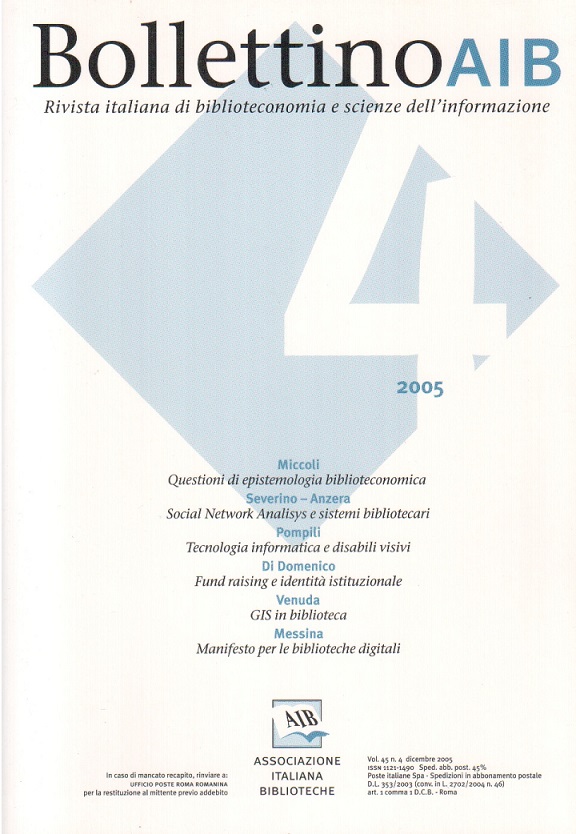La capacità organizzativa delle reti. La Social Network Analisys sui sistemi bibliotecari: il caso civico romano
Contenuto principale dell'articolo
Abstract
Which are truly the relationships inside an organization?
How is it possible to exploit the technology to improve the communication and the informational flows among people, groups and organizations?
Each person working in an organization is part of a social network which is not mapped in any formal organigram.
In practice, the goal of the Social Network Analysis (SNA) is to find and analize data and information to discover any relations and interaction models among entities.
A traditional organigram shows formal relationships (who works and where, what and for whom) while a SNA chart shows informal links (who knows who, who shares information with whom).
This allows the organization to understand and to improve the relationships which can either facilitate or hamper the creation and the copartnership of knowledge. Generally this links inside the organization are invisible, and therefore, SNA plays a detective role aimed to discover true networks which operate under the formal organizational structure and which show the means of improvement.
The SNA activity inside the organization can be carried out either once, or can be part of a more complete and recurrent approach directed to improve the internal communication flows.
The main aim of SNA is to ask people belonging to the organization for an evaluation of the importance and the utility of a particular type of information, of the gatekeepers, of the frequency of updating and of the quality of interaction.
The SNA process uses questionaries and interwievs to collect data.
A specific software, such as UCINET, analyses the collected answers, with the aim of drawing a map of information network containing all the correlated details such as degree, closeness, betweenness which describe the position of each subject on the basis of their nearness to the centre of the considered network.
This process provides the basic information which is employed to plan changes of the network on the basis of the priorities with the aim of improving the links and the knolwledge streams among existing groups.
The new information will allow the flow of knowledge exchange to be improved. This will permit not to repeat the same errors and to avoid to invent the same problem solutions, to react faster to changes and to use the information and the proper skills when decisions are made.
Social Network Analysis is a good tool both for the organization having high informational density that need reliable internal communicational process and for the ones pursueing a continuos improvement of the organization.
This methodology was applied for the first time in Italy to a libraries network. This study concerns the Istituzione Biblioteche di Roma.
How is it possible to exploit the technology to improve the communication and the informational flows among people, groups and organizations?
Each person working in an organization is part of a social network which is not mapped in any formal organigram.
In practice, the goal of the Social Network Analysis (SNA) is to find and analize data and information to discover any relations and interaction models among entities.
A traditional organigram shows formal relationships (who works and where, what and for whom) while a SNA chart shows informal links (who knows who, who shares information with whom).
This allows the organization to understand and to improve the relationships which can either facilitate or hamper the creation and the copartnership of knowledge. Generally this links inside the organization are invisible, and therefore, SNA plays a detective role aimed to discover true networks which operate under the formal organizational structure and which show the means of improvement.
The SNA activity inside the organization can be carried out either once, or can be part of a more complete and recurrent approach directed to improve the internal communication flows.
The main aim of SNA is to ask people belonging to the organization for an evaluation of the importance and the utility of a particular type of information, of the gatekeepers, of the frequency of updating and of the quality of interaction.
The SNA process uses questionaries and interwievs to collect data.
A specific software, such as UCINET, analyses the collected answers, with the aim of drawing a map of information network containing all the correlated details such as degree, closeness, betweenness which describe the position of each subject on the basis of their nearness to the centre of the considered network.
This process provides the basic information which is employed to plan changes of the network on the basis of the priorities with the aim of improving the links and the knolwledge streams among existing groups.
The new information will allow the flow of knowledge exchange to be improved. This will permit not to repeat the same errors and to avoid to invent the same problem solutions, to react faster to changes and to use the information and the proper skills when decisions are made.
Social Network Analysis is a good tool both for the organization having high informational density that need reliable internal communicational process and for the ones pursueing a continuos improvement of the organization.
This methodology was applied for the first time in Italy to a libraries network. This study concerns the Istituzione Biblioteche di Roma.
Dettagli dell'articolo
Fascicolo
Sezione
Articoli

Questo lavoro è fornito con la licenza Creative Commons Attribuzione - Condividi allo stesso modo 4.0.
